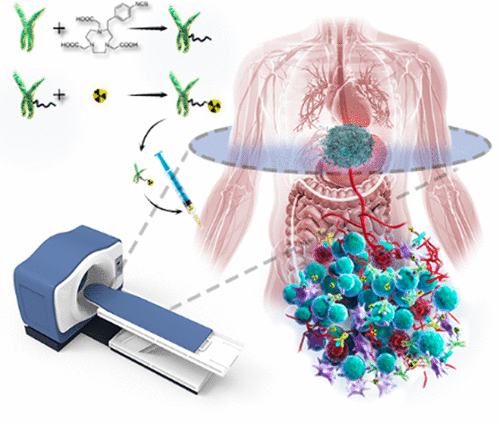当前位置:
X-MOL 学术
›
Chem. Rev.
›
论文详情
Our official English website, www.x-mol.net, welcomes your
feedback! (Note: you will need to create a separate account there.)
ImmunoPET: Concept, Design, and Applications.
Chemical Reviews ( IF 51.4 ) Pub Date : 2020-03-23 , DOI: 10.1021/acs.chemrev.9b00738 Weijun Wei 1, 2 , Zachary T Rosenkrans 3 , Jianjun Liu 1 , Gang Huang 1, 4 , Quan-Yong Luo 5 , Weibo Cai 2, 3, 6
Chemical Reviews ( IF 51.4 ) Pub Date : 2020-03-23 , DOI: 10.1021/acs.chemrev.9b00738 Weijun Wei 1, 2 , Zachary T Rosenkrans 3 , Jianjun Liu 1 , Gang Huang 1, 4 , Quan-Yong Luo 5 , Weibo Cai 2, 3, 6
Affiliation

|
Immuno-positron emission tomography (immunoPET) is a paradigm-shifting molecular imaging modality combining the superior targeting specificity of monoclonal antibody (mAb) and the inherent sensitivity of PET technique. A variety of radionuclides and mAbs have been exploited to develop immunoPET probes, which has been driven by the development and optimization of radiochemistry and conjugation strategies. In addition, tumor-targeting vectors with a short circulation time (e.g., Nanobody) or with an enhanced binding affinity (e.g., bispecific antibody) are being used to design novel immunoPET probes. Accordingly, several immunoPET probes, such as 89Zr-Df-pertuzumab and 89Zr-atezolizumab, have been successfully translated for clinical use. By noninvasively and dynamically revealing the expression of heterogeneous tumor antigens, immunoPET imaging is gradually changing the theranostic landscape of several types of malignancies. ImmunoPET is the method of choice for imaging specific tumor markers, immune cells, immune checkpoints, and inflammatory processes. Furthermore, the integration of immunoPET imaging in antibody drug development is of substantial significance because it provides pivotal information regarding antibody targeting abilities and distribution profiles. Herein, we present the latest immunoPET imaging strategies and their preclinical and clinical applications. We also emphasize current conjugation strategies that can be leveraged to develop next-generation immunoPET probes. Lastly, we discuss practical considerations to tune the development and translation of immunoPET imaging strategies.
中文翻译:

免疫PET:概念、设计和应用。
免疫正电子发射断层扫描 (immunoPET) 是一种颠覆性的分子成像方式,结合了单克隆抗体 (mAb) 卓越的靶向特异性和 PET 技术固有的灵敏度。各种放射性核素和 mAb 已被用来开发免疫 PET 探针,这是由放射化学和缀合策略的开发和优化驱动的。此外,具有短循环时间(例如,纳米抗体)或具有增强的结合亲和力(例如,双特异性抗体)的肿瘤靶向载体被用于设计新型免疫PET探针。因此,一些免疫PET探针,例如89Zr-Df-pertuzumab和89Zr-atezolizumab,已成功转化为临床使用。通过无创、动态地揭示异质肿瘤抗原的表达,免疫 PET 成像正在逐渐改变几种恶性肿瘤的治疗诊断格局。免疫PET是对特定肿瘤标志物、免疫细胞、免疫检查点和炎症过程进行成像的首选方法。此外,免疫PET成像在抗体药物开发中的整合具有重要意义,因为它提供了有关抗体靶向能力和分布概况的关键信息。在此,我们介绍最新的免疫PET成像策略及其临床前和临床应用。我们还强调当前的缀合策略可用于开发下一代免疫 PET 探针。最后,我们讨论了调整免疫 PET 成像策略的开发和转化的实际考虑因素。
更新日期:2020-04-23
中文翻译:

免疫PET:概念、设计和应用。
免疫正电子发射断层扫描 (immunoPET) 是一种颠覆性的分子成像方式,结合了单克隆抗体 (mAb) 卓越的靶向特异性和 PET 技术固有的灵敏度。各种放射性核素和 mAb 已被用来开发免疫 PET 探针,这是由放射化学和缀合策略的开发和优化驱动的。此外,具有短循环时间(例如,纳米抗体)或具有增强的结合亲和力(例如,双特异性抗体)的肿瘤靶向载体被用于设计新型免疫PET探针。因此,一些免疫PET探针,例如89Zr-Df-pertuzumab和89Zr-atezolizumab,已成功转化为临床使用。通过无创、动态地揭示异质肿瘤抗原的表达,免疫 PET 成像正在逐渐改变几种恶性肿瘤的治疗诊断格局。免疫PET是对特定肿瘤标志物、免疫细胞、免疫检查点和炎症过程进行成像的首选方法。此外,免疫PET成像在抗体药物开发中的整合具有重要意义,因为它提供了有关抗体靶向能力和分布概况的关键信息。在此,我们介绍最新的免疫PET成像策略及其临床前和临床应用。我们还强调当前的缀合策略可用于开发下一代免疫 PET 探针。最后,我们讨论了调整免疫 PET 成像策略的开发和转化的实际考虑因素。











































 京公网安备 11010802027423号
京公网安备 11010802027423号